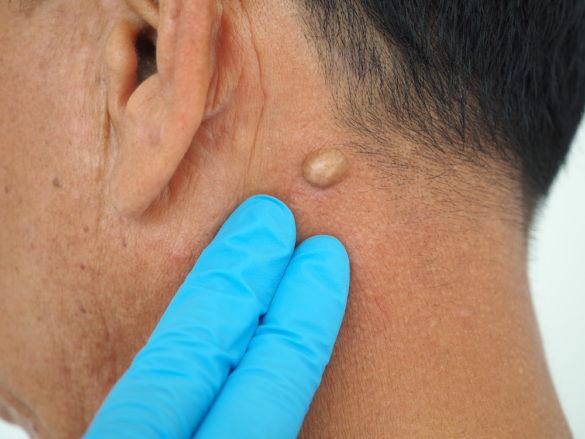 A sebaceous cyst can grow almost anywhere on your skin, but is typically found on the face, scalp, neck, or torso.
A sebaceous cyst can grow almost anywhere on your skin, but is typically found on the face, scalp, neck, or torso.
They are a round dome-shaped bump, just under the skin surface. Some are yellow or whitish and often have a small dark plug through which it may be possible to squeeze some of the cyst’s contents.
Sebaceous cysts form out of your hair follicle components. The term sebaceous cyst is now being phased out as most of these do not arise from the sebum producing glands. These cysts consist of a sac which contains semisolid cheese like material.
Cysts range in size from those that are smaller than a pea to those that are several centimetres across. Sebaceous cysts are typically not painful, but can cause embarrassment and affect a person’s self-confidence, when on your face or neck.
Types of sebaceous cysts
Sebaceous cysts cover two main types of cysts:
- Epidermoid cysts – These are one of the main types of cysts and are commonly found on the face, neck, chest, shoulders, or skin around the genitals. Epidermoid cysts usually occur in young and middle-aged adults.
- Pilar cysts – These are most common on the scalp, where several can often be found and form around hair follicles. Pilar cysts typically affect middle-aged adults, and often women. Unlike epidermoid cysts, they can run in families.
Are sebaceous cysts dangerous?
While there are many types of cysts, sebaceous cysts are common and are noncancerous cysts of the skin.
Sebaceous skin cysts do not usually hurt, although they can become tender, sore, and red if they become infected. Large cysts can also be uncomfortable when they increase in size and the pressure causes pain, depending where they are located on the body.
How to diagnose a sebaceous cyst?
A doctor or dermatologist can usually diagnose a sebaceous cyst after a simple physical examination and a history of discharge of semisolid material. Sometimes however, a cyst can mimic a lipoma which is also harmless but a very different type of lump. If there is doubt, an ultrasound examination can tell them apart. Several other conditions can also give the appearance of discharging or intact lumps in the skin giving the impression of cysts. A dermatology specialist can confirm the precise diagnosis.
A sebaceous cyst can be removed, not because they are dangerous but rather for cosmetic reasons or they feel uncomfortable or become frequently infected. A doctor can treat a cyst by draining it or surgically removing the sac. Cysts are often removed with the sac, as with simple drainage alone your cyst will usually come back.
Can a Dermatologist remove a sebaceous cyst?
The best treatment to ensure complete removal of a sebaceous cyst is through surgery, this also means the cyst will most likely not return in the future. Our dermatologists can remove a cyst without the need for a GP referral.
Cyst removals are carried out under a local anaesthetic injection which numbs the surrounding area. The lesion is then removed safely with a specialised scalpel. The wound will require stitches and you can choose to have these removed either at one of our skin clinics or at your local surgery.
It couldn’t be easier to book a cyst removal with Diamond Skin Care, simply call 01603 298395 or book online.


